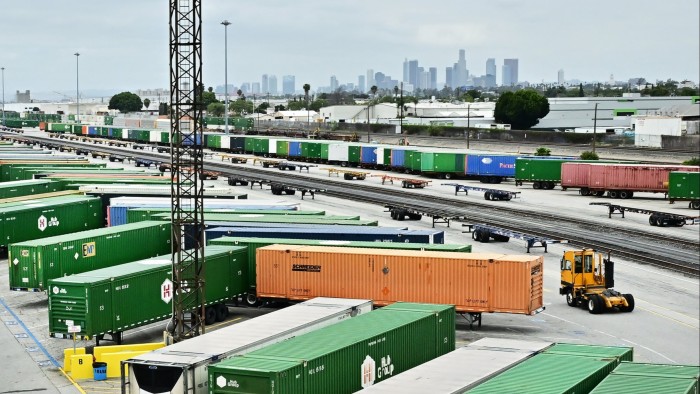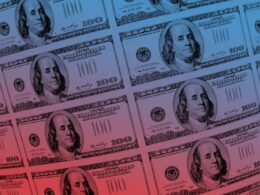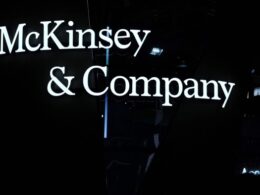Anyone who thought Donald Trump’s tariff policy would be stable after the August 1 deadline was wrong. Last week, the US president unilaterally raised tariffs further on Indian imports and announced a new 100 per cent tariff on computer chips processed outside the US.
Therefore, I hope to provide readers with a snapshot of the best evidence on the effects of tariffs on US prices so far.
Are Trump’s tariffs significant?
Before looking at the new import duties, there is an important rule of thumb that helps any analysis of US tariffs. Goods imports are roughly 10 per cent of US GDP, so a rise in the effective tariff rate of 10 percentage points would raise US prices by 1 per cent if levies were fully passed on to consumers. This is relatively modest, as the US is a fairly closed economy.
Keeping up with tariff announcements is difficult, but the Yale Budget Lab, Tax Foundation and Peterson Institute are doing a fine job. That said, the simplest way to get an up-to-date and beautifully visualised picture is the FT’s tracker.
There are three different ways to measure the scale of the duties. First, you can use a static model, which applies the new tariffs to the 2024 pattern of imports. This is the right way to think about costs to US consumers. On this basis, the overall tariff rate is now 18.6 per cent, according to the Yale Budget Lab. This is up 16.2 percentage points since January.
Such a large movement in headline tariff rates will decrease US imports and shift them to countries with lower rates.
Second, you can account for expected behavioural changes. Using this method, the Yale Budget Lab estimates the effective US tariff rate is currently 17.7 per cent. This would be the highest rate in a century.
Some economists estimate much larger behavioural effects in their models. The Tax Foundation, for example, calculates an effective tariff rate of 11.8 per cent.
Third, you can compare taxes paid at the border with imports. This will give you the correct measure of the ultimate outcome of tariffs. By this calculation, the ETR was lower at 9.1 per cent in July — but it is rising.
Why so much lower? First, there is a time lag, because tariffs are not applied to goods that have already left the origin port (and it can take up to one month for cargo ships to cross the Pacific). Moreover, there was significant front-running of tariffs earlier this year, with a surge of imports increasing inventories and lowering subsequent trade flows. Importers can also defer tariff payments for about six weeks.
Remember my rule of thumb: if the tariff rate applied so far on goods imported under the new rules is 9.1 per cent, compared with 2.5 per cent before Trump, we would expect prices to rise about 0.7 per cent if levies were fully passed through.
Are foreigners paying?
Not really.
US consumers might escape tariff costs if foreign producers lower the prices of goods sold to the US. Trump has always said foreigners will pay, and his words are implicitly endorsed by anyone who writes sentences such as “the US president has imposed 50 per cent tariffs on India”.
The best evidence I have seen that foreigners might be paying comes from Japanese carmakers. (See the Bank of Japan’s export price charts below.) The dark blue line on the left shows that Japanese car exports to North America fell about 20 per cent in dollar terms between April and June. Europeans did not get the same price reduction.
But two important pieces of context are needed. First, on the right-hand side of the chart, the same data is expressed in yen. It shows that margins on cars exported to North America had been much higher, meaning there was room to cut prices. More important, though, is the light blue line showing all manufactured exports and no drop. Japanese car prices for US consumers might have fallen, but sales volumes were so small that they did not show up in the figures.
Goldman Sachs has created a model to examine the movement of import prices in response to tariffs, using product-level figures and tariff rates. It is an ambitious way to understand the data. But the results are unstable because trade patterns and prices are changing so rapidly.
In July, the investment bank estimated that foreign exporters absorbed 20 per cent of Trump’s tariffs. It has now trimmed that estimate to 14 per cent, but said if the early effects continue, that number would rise to 25 per cent. This is really interesting and important work, but my view is that it is probably too early to do this sort of analysis.
If you cannot do fancy estimates, you can look at overall US customs data for import prices before tariffs are applied. These clearly show the US paying.
Overall, import prices of industrial goods have been rising since Trump’s inauguration. Only import prices from China have been falling, as they were before tariffs were applied.
For now, it is probably best to assume that the vast majority, but not 100 per cent, of the costs are being borne by the US.
Are companies sucking tariffs up with reduced margins?
Yes, for now.
Companies are complaining of reduced margins and are hinting at raising prices. My colleagues at Unhedged had a good recent summary, and this week Guy Chazan wrote a lovely boots-on-the-ground analysis from St Louis.
Business surveys allow us to aggregate these examples, and the latest from US manufacturers makes for difficult reading. An increasing number are reporting rising input and output prices. Tariffs on intermediate goods such as steel have consequences.
It is not easy to translate these surveys into percentage points on inflation. But the last time input and output prices were showing such readings in the US PMI index, inflation soon followed.
How are tariffs affecting inflation expectations?
Not much. But do not take comfort from that.
Whether it is market inflation expectations or household expectations, they have risen and are above the Federal Reserve’s inflation target. But they have not moved much.
That is good news for the Fed, but no cause for complacency. Inflation expectations tend to move with inflation itself, and they were not a useful predictor in 2021 and 2022.
What can we see in inflation data?
Modest effects so far.
So long as you remember that goods imports are small in the US, there are significant price effects visible in the supply chain. These have so far generated modest price increases for consumers, as inventory is sold and companies have yet to show much sign of expanding margins.
Harvard Business School’s Pricing Lab looks at daily online prices, split between imports and US-made goods. It calculates that tariff announcements have led to import price increases of 4 to 5 per cent, hikes that have not occurred for domestic products. That figure is consistent with Fed chair Jay Powell’s comment at his July press conference that the central bank estimates “three- or four-tenths of inflation in core inflation [come] from tariffs”.
The latest CPI data for July, published on Tuesday, again shows a clear effect of tariffs, with goods price inflation, food and core inflation, trending higher. It is offset in the headline figures by falling energy prices. Services inflation was stable at 3.6 per cent.
With this data, the Fed could easily justify waiting longer before cutting interest rates, even with weak payroll data. This story certainly does not have to end in high inflation — but there are still some chapters left to write.
What I’ve been reading and watching
-
Delphine Strauss produced a wonderful account of the difficulties facing the Bank of England when inflation is behaving badly.
-
Former Fed economist Claudia Sahm has written the best analysis of the US labour market after the big data revisions I have read.
-
Our US reporters have everything you might want to read on the Fed chair runners and riders.
-
At the FT’s Monetary Policy Radar, Elettra Ardissino looks at what we know about Trump’s pick for Fed governor, Stephen Miran.
A chart that matters
Central banks always face a dilemma when faced with one-off price rises caused by government policies.
The BoE is dealing with services inflation that has not fallen since last October, raising the question of whether the disinflationary process has stalled. UK services prices have been pushed higher by large increases in water and sewerage costs after a five-year price review; the imposition of VAT at 20 per cent on private school fees; a cut in bus fare subsidies and a rise in vehicle taxes on new cars. These are all plausibly one-off price hikes.
When the BoE strips out these effects, the gradual disinflation trend continues.
Should you strip out price effects you do not like much? The chart below explains the difference in views between the five Monetary Policy Committee members who voted to cut rates after arguing that underlying disinflation was still on track, and the four voting to hold who wanted more evidence of waning inflation before moving.
It is not the same debate as in the US, but it has similarities. This is an uncomfortable chart for people — me included — who think the Fed should hold and the BoE should cut.
Central Banks is edited by Harvey Nriapia
Source link
















